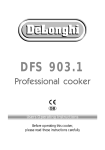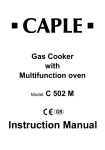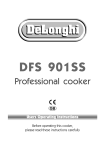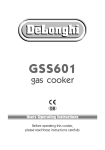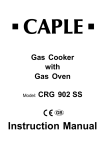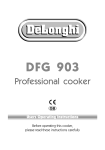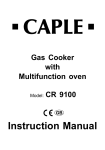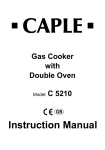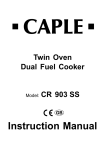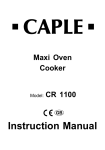Download DeLonghi DFS 090 SO Operating instructions
Transcript
GB Users Operating Instructions Before operating this cooker, please read these instructions carefully DFS 090 SO Dual Fuel Cooker Introduction Congratulations on your purchase of this Delonghi Cooker which has been carefully designed and produced to give you many years of satisfactory use. Before using this appliance it is essential that the following instructions are carefully read and fully understood. We would emphasise that the installation section must be fully complied with for your safety to ensure that you obtain the maximum benefits from your appliance. CE Declaration of conformity This cooker has been designed, constructed and marketed in compliance with: - safety requirements of EEC Directive “Gas” 90/396; - safety requirements of EEC Directive “Low voltage” 73/23; - protection requirements of EEC Directive “EMC” 89/336; - requirements of EEC Directive 93/68. GB This appliance is designed and manufactured solely for the cooking of domestic (household) food and in not suitable for any none domestic application and therefore should not be used in a commercial environmement. The appliance guarantee will be void if the appliance is used within a none domestic environnement i.e. a semi commercial, commercial or communal environment. 2 Important precautions and recommendations After having unpacked the appliance, check to ensure that it is not damaged. In case of doubt, do not use it and consult your supplier or a professionally qualified technician. Packing elements (i.e. plastic bags, polystyrene foam, nails, packing straps, etc.) should not be left around within easy reach of children, as these may cause serious injuries. ■ Do not attempt to modify the technical characteristics of the appliance as this may become dangerous to use. ■ Do not carry out cleaning or maintenance operations on the appliance without having previously disconnected it from the electric power supply. ■ After use, ensure that the knobs are in off position. ■ ■ ■ ■ ■ ■ ■ ■ ■ ■ ■ ■ Do not allow children or other incapable people to use the appliance without supervision. During and after use of the cooker, certain parts will become very hot. Do not touch hot parts. Keep children away from the cooker when it is in use. Some appliances are supplied with a protective film on steel and aluminium parts. This film must be removed before using the appliance. Fire risk! Do not store flammable material in the oven, and in the storage compartment. Make sure that electrical cables connecting other appliances in the proximity of the cooker cannot come into contact with the hob or become entrapped in the oven door. Do not line the oven walls with aluminium foil. Do not place baking trays or the drip tray on the base of the oven chamber. The manufacturer declines all liability for injury to persons or damage to property caused by incorrect or improper use of the appliance. To avoid any possible hazard, the appliance must be installed by qualified personnel only. Any repairs by unqualified persons may result in electric shock or short circuit. In order to avoid possible injuries to your body or to the appliance, do not attempt any repairs by yourself. Such work should be carried out by qualified service personnel only. Danger of burns! The oven and cooking accessories may become very hot during operation. Make sure children are kept out of reach and warn them accordingly. To avoid burns use kitchen clothes and gloves when handling hot parts or utensils. Never clean the oven with a high-pressure steam cleaning device, as it may provoke a short circuit. This appliance is intended for use in your household. Never use the appliance for any other purpose! 3 1 Features and technical data 2 2 4 1 3 Fig. 1.1 Gas burners 1. 2. 3. 4. 4 Auxiliary burner (A) Semi-rapid burner (SR) Rapid burner (R) Double-ring burner (PB) 1,00 kW 1,90 kW 3,15 kW 3,45 kW 2 Control panel Fig. 2.1 10 A U T O 1 2 3 4 5 6 7 8 9 CONTROL PANEL - Controls description 1. Electronic clock/end cooking timer 2. Fan oven switch knob 3. Fan oven thermostat knob 4. Front left burner control knob 5. Rear left burner control knob 6. Central burner control knob 7. Rear right burner control knob 8. Front right burner control knob Pushbutton and pilot lamps: 9. Electronic ignition pushbutton 10. Oven indicator light 5 3 Electronic clock/end cooking timer The electronic programmer is a device with the following functions: – 24 hours clock with illuminated display – Timing of oven cooking with automatic switch-off (max. 99 minutes). Electronic clock Upon immediate connection of the oven or after a mains failure, three zeros will flash on the programmer panel. To set the clock it is necessary to push the button and then, within 7 seconds, the or button until you have set the correct time. The clock will show zero after a mains failure. Attention: When the programmer display shows three flashing zeros the oven cannot be switched on. The oven can be switched on when the symbol is shown in the display. Setting the frequency of the alarm sound The selection from 3 possibilities of sound can be made by pressing the button. A U T O Fig. 3.1 6 Cooking with automatic switch-off The aim of this function is to automatically stop the cooking after a pre programmed time, for a maximum period of 99 minutes. To set the cooking time, push the or button until you obtain the desired time in the display. The symbol AUTO will be shown in the display. Then you adjust the oven thermostat knob according to the required temperature. The oven will immediately start to operate and will work for the pre programmed time. The display shows the count down. Clock time can be displayed by pressing the button. Once the time has elasped, the oven will switch off automatically, the symbol AUTO will go off and an intermittent buzzer, lasting 7 minutes, will start; this can be stopped by pressing the button. Important: Before the buzzer is stopped switch off the oven manually. To cancel the cooking program at any time press the and buttons together and release the button first. Electronic alarm The programmer can be used as an alarm only for a maximum period of 99 minutes. To set the alarm, push the or button until you obtain the desired time in the display. Once the time has elasped, an intermittent buzzer, lasting 7 minutes, will start; this can be stopped by pressing the button. Attention: If the bottom oven is switched on when the buzzer starts, it will be automatically switched off. For it to operate furtherly you have to stop the buzzer by pressing the button. 4 How to use the hob burners Hob burners Each hob burner is controlled by a separate gas tap operated by a control knob (fig. 4.1) which has 3 positions marked on the control panel, these are: – Symbol ● : tap closed (burner off) – Symbol : High (maximum) – Symbol Fig. 4.1 : Low (minimum) Push in and turn the knob anti-clockwise to the selected position. Low High To turn the burner off, fully rotate the knob clockwise to the off position: ●. The maximum setting of the control tap is for boiling, the minimum setting is for slow cooking and simmering. All working positions must be choosen between the maximum and minimum setting, never between the maximum setting and the “OFF” position. Electric ignition The sparks generated by the electrodes close to the burners will ignite the choosen burner. Whenever the lighting of the burners is difficult due to peculiar conditions of the gas features or supply, it is advised to repeat the ignition with the knob on “minimum” position. Lighting of the hob burners To ignite the burner, the following instructions are to be followed: 1) Lightly press and turn the knob anti-clockwise, and position the knob indicator to the symbol (high - maximum) printed on the control panel (fig. 4.1). 2) Press the push-button marked (fig. 4.2) to operate the electric ignition; or, in the case of a mains failure light the burner with a match or lighted taper. Fig. 4.2 3) Adjust the burner according to the setting required. 7 Choice of burner The burner must be choosen according to the diameter of the pans and energy required. Burners Pan diameter Auxiliary Semi-rapid Rapid Double-ring 12 ÷ 16 cm 16 ÷ 22 cm 20 ÷ 24 cm up to 30 cm Fig. 4.3 do not use pans with concave or convex bases Saucepans with handles which are excessively heavy, in relationship to the weight of the pan, are safer as they are less likely to tip. Pans which are positioned centrally on burners are more stable than those which are offset. It is far safer to position the pan handles in such a way that they cannot be accidentally knocked. When deep fat frying fill the pan only one third full of oil. DO NOT cover the pan with a lid and DO NOT leave the pan unattended. In the unfortunate event of a fire, leave the pan where it is and turn off all controls. Place a damp cloth or correct fitting lid over the pan to smother the flames. DO NOT use water on the fire. Leave the pan to cool for at least 30 minutes. 8 5 How to use the Fan electric oven General features Operating principles Attention: the oven door becomes very hot during operation. Keep children away. Heating and cooking in the FAN oven are obtained in the following ways: The heating and cooking in electrical hot air ovens take place by forced convection. The two elements which make this process take place are: - Circular element - Grill element 2500 W 2200 W NOTE: Upon first use, it is advisable to operate the oven at the maximum temperature (thermostat knob on position 250) for 60 minutes in the position (fan oven) and for another 15 minutes in the position (thermostat knob on position 200°C), to eliminate possible traces of grease on the heating elements. a. by forced convection A fan sucks in the air contained in the oven muffle, which sends it through the circular heating element and then sends it back through the muffle. Before the hot air is sucked back again by the fan to repeat the described cycle, it envelops the food in the oven, provoking a complete and rapid cooking. It is possible to cook several dishes simultaneously. b. by radiation The heat is radiated by the infra red grill element. c. by ventilation The food is defrosted by using the fan only function without heat. WARNING: The door is hot, use the handle. 9 Fig. 5.2 Fig. 5.1 Thermostat knob (Fig. 5.2) This only sets the cooking temperature and does not switch the oven on. Rotate clockwise until the required temperature is reached (from 50 to 250°C). The light above the temperature selector will illuminate when the oven is swiched on and turns off when the oven reaches the correct temperature. The light will cycle on and off during cooking in line with the oven temperature. Function selector knob (Fig. 5.1) Rotate the knob clockwise to set the oven for one of the following functions. OVEN LIGHT By setting the knob to this position, only the oven light comes on (15 W). It remains on in all the cooking modes. DEFROSTING FROZEN FOODS Only the oven fan comes on. Use with the thermostat knob set to “●” - other positions have no effect. The food is thawed by ventilation without heating. Recommended for: Quick thawing of frozen foods; one kg requires approximately 1 hour. Thawing times vary according to the quantity and type of food to be thawed. 10 HOT AIR COOKING The circular element and fan come on. The heat is dispersed by forced convection and the temperature can be regulated to between 50° and 250°C via the thermostat knob. The oven does not require preheating. Recommended for: Food which has to be well-cooked outside and soft or rosy inside, for example lasagne, lamb, roast beef, whole fish etc. GRILLING The infrared grill element comes on. The heat is dispersed by radiation. Set the thermostat knob to between 50° and 200°C. Always grill with the oven door closed. For cooking hints, see the chapter “USE OF THE GRILL”. Recommended for: Intense grilling, browning, cooking au gratin and toasting etc. Do not grill for longer than 30 minutes at any one time on full heat (200°C). Caution: the oven door becomes very hot during operation. Keep children well out of reach. Cooking advice STERILIZATION Sterilization of foods to be conserved, in full and hermetically sealed jars, is done in the following way: a. b. c. d. Set the switch to position . Set the thermostat knob to position 185 °C and preheat the oven. Fill the dripping pan with hot water. Set the jars onto the dripping pan making sure they do not touch each other and the door and set the thermostat knob to position 135 °C. When sterilization has begun, that is, when the contents of the jars start to bubble, turn off the oven and let cool. 11 REGENERATION Set the switch to position and the thermostat knob to position 150° C. Bread becomes fragrant again if wet with a few drops of water and put into the oven for about 10 minutes at the highest temperature. ROASTING To obtain classical roasting, it is necessary to remember: – that it is advisable to maintain a temperature between 180° and 200 °C. – that the cooking time depends on the quantity and the type of foods. SIMULTANEOUS COOKING OF DIFFERENT FOODS The FAN consents a simultaneous heterogeneous cooking of different foods. Different foods such as fish, cake and meat can be cooked together without mixing the smells and flavors together. This is possible since the fats and vapors are oxidized while passing through the electrical element and therefore are not deposited onto the foods. The only precaution to follow are: – The cooking temperatures of the different foods must be as close to as possible, with a maximum difference of 20° - 25 °C. – The introduction of the different dishes in the oven must be done at different times in relation to the cooking times of each one. The time and energy saved with this type of cooking is obvious. USE OF THE GRILL Preheat the oven for about 5 minutes. Introduce the food to be cooked, positioning the rack as close to the grill as possible. The dripping pan should be placed under the rack to catch the cooking juices and fats. Grilling with the oven door closed. Do not grill for longer than 30 minutes at any one time on full heat (200°C). Caution: the oven door becomes very hot during operation. Keep children well out of reach. Safety guard The glass on the oven door reaches high temperatures during operation. For child safety, a door guard can be fitted to prevent contact with the hot glass. The door guard is supplied as an accessory on request. Contact one of our dealers or Service Centre and indicate the relevant appliance model. 12 Cooking guide Temperature and times given are approximate, as they will vary depending on the quality and amount of food being cooked. Remember to use ovenproof dishes and to adjust the oven temperature during cooking if necessary. Oven cooking temperatures APPROX. TEMPERATURE MARK HEAT OF OVEN TYPE OF DISH TO COOK 125°C (257°F) 4 Very cool oven Meringue, slow cooking foods. 135°C - 140°C (275°F - 285°F) 4-5 Cool or slow oven Milk puddings, very rich fruit cakes, eg., Christmas. 150°C (300°F) 5 Cool or slow oven Stews, casseroles, braising, rich fruit cakes, eg., Dundee. 160°C - 170°C (320°F - 338°F) 5-6 Warm oven Biscuits, Low temperature roasting, rich plain cakes eg., Madeira cake. 180°C (356°F) 6 Moderate oven Plain cakes, eg., Victoria sandwich, meat pies. 190°C (374°F) 6-7 Fairly hot oven Small cakes, savoury flans, fish. 200°C (392°F) 7 Hot oven Plain cakes and buns, swiss rolls, fruit pies. High temp. roasting. 220°C (428°F) 8 Moderately hot oven Bread and bread rolls etc., scones, flaky and rough puff pastry, Yorkshire pudding. 230°C (446°F) 8-9 Very hot oven Sausage rolls, mince pies, puff pastry. 250°C (482°F) 9 Very hot oven Browning ready cooked dishes. 13 Important notes Installation, and any demonstration, information or adjustments are not included in the warranty. The cooker must be installed by a qualified person in accordance with the Gas Safety (Installation and Use) (Amendment) Regulations 1990 and the relevant building/l.E.E Regulations. Failure to install the appliance correctly could invalidate any manufacturers warranty and lead to prosecution under the above quoted regulation. In the UK C.O.R.G.I registered installers are authorised to undertake the installation and service work in compliance with the above regulations. All Comet authorised installers are C.O.R.G.I. registered. Attention The appliance gets very hot, mainly around the cooking areas. It is very important that children are not left alone in the kitchen when you are cooking. After Sales Service Should you require to book a service call telephone 0870 5425425. For product information and advise telephone 0113 2793520 14 Do’s and do not’s Do’s and do not’s • Do always grill with the oven door closed. • Do read the user instructions carefully before using the cooker for first time. • Do allow the oven to heat for one and a half hours, before using for the first time, in order to expel any smell from the new oven insulation, without the introduction of food. • Do clean your oven regularly. • Do remove spills as soon as they occur. • Do always use oven gloves when removing food shelves and trays from the oven. • Do not allow children near the cooker when in use. • Do not allow fat or oils to build up in the oven trays, or oven base. • Do not place cooking utensils or plates directly onto the oven base. • Do not grill food containing fat without using the grid. • Do not cover the grilling grid with aluminium-foil. • Do not use the oven tray for roasting. • Do not place hot enamel parts in water. Leave them to cool first. • Do not allow vinegar, coffee, milk, saltwater, lemon or tomato juice to remain in contact with enamel parts (inside the oven and on the oven tray). • Do not use abrasive cleaners or powders that will scratch the surface of the stainless steel and the enamel. • Do not attempt to repair the internal workings of your cooker. • Do remove the protective film before the first use. • Fire risk! Do not store flammable material in the oven and in the storage compartment. For your safety The product should only be used for its intended purpose which is for the cooking of domestic foodstuffs. Under no circumstances should any external covers be removed for servicing or maintenance except by suitably qualified personnel. 15 6 Care and maintenance Important: As a safety measure, before you start cleaning the cooker be sure to disconnect it from the mains supply. Do not use a steam cleaner because the moisture can get into the appliance thus make it unsafe. Important: The use of suitable protective clothing/gloves is recommended when cleaning of this appliance. Cleaning the hob Spillage on the hob can usually be removed by a damp soapy cloth. More obstinate stains can be removed by rubbing gently with a soapy scouring pad or mild household cleaner. Gas taps If a tap becomes stiff, do not force; contact your local Service Centre. Flexible tube From time to time, check the flexible tube connecting the gas supply to the cooker. It must be always in perfect condition; in case of damage arrange for it to be replaced by a C.O.R.G.I. registered installer. Cleaning oven parts after use The oven interior and the chromium plated shelves can be cleaned by damp soapy cloth. Obstinate stains can be removed with nylon scouring pads and gentle, non-abrasive, liquid cleaner. Provided the oven is wiped over immediately after roasting, only the minimum of cleaning should be necessary. Stainless steel aluminium parts and silk-screen printed surfaces Clean using an appropriate product. Always dry thoroughly. IMPORTANT: these parts must be cleaned very carefully to avoid scratching and abrasion. You are advised to use a soft cloth and neutral soap. CAUTION: Do not use abrasive substances or non-neutral detergents as these will irreparably damage the surface. 16 Burners They can be removed and washed with soapy water only. They will remain always perfect if cleaned with products used for silverware. After each cleaning, make sure that the burner-caps, as well as the burners, have been well wiped off and CORRECTLY POSITIONED. It is essential to check the correct position of the burner-caps as the least displacement from the housing may cause serious problems. Special attention has to be paid in order not to exchange the housing of the two small burners shown in fig. 6.1. The burner caps can be interchangeable. Check also that the electrodes for ignition be always clean in order to ensure a regular spark shooting. Fig. 6.1 Burner-cap ring partially drilled Burner-cap ring fully drilled Changing the oven light 1. Disconnect the electrical power supply (for example, by switching off the main power switch). 2. Unscrew the light cover 3. Fit a new bulb. 4. Refit the cover. Note: Use only bulbs designed to resist up to 300°C with the following characteristics: 15 W, 230 V, type E-14. Oven bulb replacement is not covered by your guarantee. 17 Removal of the inner glass door panel – The inner glass door panel can easily be removed for cleaning by unscrewing the four screws (fig. 6.2). – When re-assembly ensure that the inner glass is correctly positioned and do not over tighten the screws. Fig. 6.2 Storage compartment – The storage compartment is accessible through the pivoting panel. Do not store flammable material in the oven or in the storage compartment. Fig. 6.3 18 Inside of oven This must be cleaned regularly. Remove and refit the side runner frames as described on the next chapter. With the oven warm, wipe the inside walls with a cloth soaked in very hot soapy water or another suitable product. The bottom of the oven, side runner frames, tray and rack can be removed and washed. Fig. 6.4 Assembling and dismantling of the side runner frames – Fit the side runner frames into the holes on the side walls inside the oven (Fig. 6.4). – Slide the tray and rack into the runners (Fig. 6.5). – The rack must be fitted so that the safety catch, which stops it sliding out, faces the inside of the oven. – To dismantle, operate in reverse order. Fig. 6.5 19 Oven tray The oven tray “L” must be correctly placed on its wire shelf support (fig. 6.6) then insert into the side runners (fig. 6.7). Oven floor The oven floor “F” (fig. 6.7) can be easily removed to facilitate cleaning. Remember to replace the floor correctly afterwards. Be careful not to confuse the tray “L” with the oven floor “F”. L Fig. 6.6 L F Fig. 6.7 20 Removing the oven door Fig. 6.8a Please operate as follows: ● ● ● ● Open the door completely. The swivel retainers of the rh and lh hinges (fig. 6.8a) are hooked onto the metal bar above them (fig. 6.8b). Lift the oven door slightly. The noch on the bottom of the hinge will disengage (fig. 6.8c). Now pull the oven door forwards off the appliance. Release both hinge sections from the slots (fig. 6.8d). Fig. 6.8b Door assembly ● Grip the door (as indicated in figure 6.8) and refit it in reverse order of removing procedure. Fig. 6.8c Fig. 6.8d Fig. 6.8 21 FOR THE INSTALLER 7 Location This cookers has type “X” overheating protection. If the cooker is installed adjacent to furniture which is higher than the gas hob cooktop, a gap of at least 50 mm must be left between the side of the cooker and the furniture. The furniture walls adjacent to the cooker must be made of material resistant to heat. The veneered syntetical material and the glue used must be resistant to a temperature of 90°C in order to avoid ungluing or deformations. The cooker may be located in a kitchen, a kitchen/diner or bed-sitting room but not in a room containing a bath or shower. Curtains must not be fitted immediatly behind appliance or within 500 mm of the sides. It is essential that the cooker is positioned as stated below. The cooker must be installed by a qualified technician and in compliance with local safety standards. If the cooker is located on a pedestal it is necessary to provide safety measures to prevent falling out. Important: 450 mm 750 mm The use of suitable protective clothing/gloves is recommended when handling, installing or cleaning of this appliance. 50 mm 500 mm A U T O t ven air 22 Fig. 7.1 Fitting the adjustable feet The adjustable feet must be fitted to the base of the cooker before use. Rest the rear of the cooker an a piece of the polystyrene packaging exposing the base for the fitting of the feet. Fig. 7.2 Moving the cooker WARNING When raising cooker to upright position always ensure two people carry out this manoeuvre to prevent damage to the adjustable feet (fig. 7.3). WARNING Be carefull: do not lift the cooker by the door handle when raising to the upright position (fig. 7.4). Fig. 7.3 WARNING When moving cooker to its final position DO NOT DRAG (fig. 7.5). Lift feet clear of floor (fig. 7.3). Fig. 7.5 Fig. 7.4 Levelling the cooker The cooker may be levelled by screwing the lower ends of the feet IN or OUT (fig. 7.6). Fig. 7.6 23 Stability bracket We recommend a stability bracket is fitted to the cooker. The type shown in fig. 7.7 can be purchased from most plumbers merchants and do it yourself (D.I.Y.) shops. Existing slot in rear of cooker Brackets Fig. 7.7 Dotted line showing the position of cooker when fixed 3 Outline of cooker backplate at the engagement slot Wall fixing Floor fixing Dimension is in millimetres 24 Backguard Assembling the backguard 1. Insert the side supports S and D into the backguard B (see fig. 7.8) 2. Insert the backguard group into the support guides in the cooker 3. The backguard can be removed for cleaning or fixed with a screw through the hole C. D B S C Fig. 7.8 25 Provison for ventilation The room containing the cooker should have an air supply in accordance with BS.5540: Part 2: 1989. All rooms require an openable window or equivalent while some rooms require a permanent vent in addition to the openable window. The cooker should not be installed in a bed-sitting room, of volume less than 21 m3. Where a DOMESTIC COOKER is installed in a room or internal space, that room or internal space shall be provided with a permanent opening which communicates directly with outside air and is sized in accordance with table below. In domestic premises the permanent opening shall be an air vent. If there are other fuel burning appliances in the same room, BS.5540: Part 2: 1989 should be consulted to determine the requisite air vent requirements. If the cooker is installed in a cellar or basement, it is advisable to provide an air vent of effective area 100 cm2, irrespective of the room volume. MINIMUM PERMANENT OPENING FREE AREA FOR FLUELESS APPLIANCE Type of appliance Domestic oven, hotplate, grill or any combination thereof. > 20 m3 Openable window or equivalent also required Nil cm2 Yes Room volume Maximum appliance rated input limit < 5 m3 None 100 cm2 5 m3 to 10 11 m3 to m3 20 m3 50 (❊) cm2 Nil cm2 (❊) If the room or internal space containing these appliances has a door which opens directly to outside, no permanent opening is required. 26 8 Gas installation IMPORTANT NOTE This appliance is supplied for use on NATURAL GAS only and cannot be used on any other gas without modification. This appliance is manufactured for conversion to LPG and is supplied with a conversion kit. The cooker must be installed by a qualified person in accordance with the Gas Safety (Installation and Use) (Amendment) Regulation 1990 and the relevant building/l.E.E. Regulations. The following British Standards should be used as reference when installing this appliance. BS6172 1990, BS5440 part 2 1989 and BS6891 1988. Failure to install the appliance correctly could invalidate any manufacturers warranty and lead to prosecution under the above quoted regulation. In the UK C.O.R.G.I registered installers are authorised to undertake the installation and service work in compliance with the above regulations. Gas connection The installation of the cooker to Natural Gas or LP Gas must be carried out by a qualified gas engineer. Installer shall take due account of the provisions of the relevant British Standards Code of Practice, the Gas Safety Regulations and the Building Standards (Scotland) (Consolidation) Regulations issued by the Scottish Development Department. Installation to Natural Gas Installation to Natural Gas must conform to the Code of Practice, etc. The supply pressure for Natural Gas is 20 mbar. 27 Installation to LP Gas This appliance must only be connected to LPG after an LPG conversion kit has been fitted, (see pages from 29 to 31). When operating on Butane gas a supply pressure of 28-30 mbar is required. When using Propane gas a supply pressure of 37 mbar is required. The installation must conform to the relevant British Standards. Warning: Only a qualified gas engineer, also with technical knowledge of electricity should install the cooker. He should observe the Regulations and Codes of Practice governing such installation of gas cookers. Note: It is recommended that the gas connection to the cooker is installed with a flexible connecting tube made to BS 5386. Gas connection The gas supply must be connected to the gas inlet which is located at the left or the right hand rear of the appliance (see figure 8.1). The pipe do not cross the cooker. To screw the connecting tube operate with two spanners (see fig. 8.2). The unused end inlet pipe must be closed with the plug interposing the gasket. After connecting to the mains, check that the coupling are correctly sealed, using soapy solution, but never a flame. Plug Fig. 8.1 28 Fig. 8.2 Conversion to LPG Injectors replacement of top burners To replace the injectors it is necessary to lift the hobtop and proceed as follows: – Remove pan-supports and burners from the hobtop. – Remove the backguard “E”. – Unscrew the screws “B” and remove the sockets and the side trims (Fig. 8.3). – Unscrew the screw “C”. – Pull forwards the hobtop to release it, then lift following arrow “E” (Fig. 8.3) – Hold the hobtop open by a support. – Fully raise the adjusting air tube A (fig. 8.4) in order to easily reach the injector. – By an angle 7 spanner, remove the injector from its housing and replace it by the proper one according to the kind of gas (see “Table for the choice of the injectors” - page 31). E B C E B E Fig. 8.3 29 Adjusting of primary air of the top burners By operating the screw “M”, reset the air adjuster “A” according to the instructions see “Injector table”, where the distance between injector and air adjuster is recommended (in mm). Before lowering the hob top, set the burners on their sites and light them in order to check whether the flames are correct, as per the specifications given in the next page. In case of uncorrect flame, lift or lower the air adjuster. Flame faulty in primary air Flame correct Flame with excess primary air long, yellow and trembling clear interior blue cone short and sharptoo blue interior cone tending to detach CAUSE air regulating tube, too closed correct distance of the tube air regulating tube, too open Adjusting of the minimum of the top burners Considering that in the minimum position the flame must have a length of about 4 mm and must remain lit even with a quick turn from the maximum position to that of minimum. The flame adjustment is done in the following way: – Turn on the burner – Turn the tap to the MINIMUM position – Take off the knob – With a small flat screwdriver turn the screw inside the tap rod to the correct regulation (fig. 8.5). Normally for LPG, tighten up the regulation screw. M J A Fig. 8.4 30 Fig. 8.5 Table for the choice of the injectors GB Cat: II 2H3+ G 20 20 mbar G 30 - 28-30 mbar G 31 - 37 mbar Nominal Power Reduced Power [kW] [kW] Auxiliary (A) 1,00 0,30 50 Semi-rapid (SR) 1,90 0,38 67 Rapid (R) 3,15 0,60 86 Double-ring (PB) 3,45 0,85 92 BURNERS Ø injector Ring opening Ø injector Ring opening [1/100 mm] [mm] [1/100 mm] [mm] 3* 72 1* 5,7 * 100 2* fully open * 130 5* fully open * 135 5* * = Reference value INCREASE OF AIR NECESSARY FOR GAS COMBUSTION (2 m3/h x kW) BURNERS Air necessary for combustion [m3/h] Auxiliary (A) 2,00 Semi-rapid (SR) 3,80 Rapid (R) 6,30 Double-ring (PB) 6,90 Lubrication of the gas taps The operations must be executed by a qualified technician. 31 9 Electrical installation WARNING! ELECTRICITY CAN BE EXTREMELY DANGEROUS. THIS APPLIANCE MUST BE EARTHED. The appliance must be connected to the electrical network verifying above all that the voltage corresponds to the value indicated on the specifications plate and that the cables section of the electrical plant can bear the load which is also indicated on the plate. The cooker can be connected directly to the mains placing an omnipolar switch with minimum opening between the contacts of 3 mm between the appliance and the mains. The power supply cable must not touch the hot parts and must be positioned so that it does not exceed 75°C at any point. Once the cooker has been installed, the switch or socket must always be accessible. Before effecting any intervention on the electrical parts the appliance must be disconnected from the network. ; ; ; ; ; ; ; ;;; ;;; Connecting feeder cable To connect the feeder cable to the cooker it is necessary to: – Remove the screw that hold shield “A” behind the cooker (fig. 9.1). – Insert the feeder cable of the suitable section (as described in the next chapter) into the cable clamp “D”. – Connect the phase and earth cables to the terminal block “B” according to the diagram in figure 9.2. – Pull the feeder cable and block it with cable clamp “D”. – Re-mount shield “A”. PE B A Fig. 9.1 230 V Feeder cable section type H05RR-F 230 V 3 x 1,5 mm2 Fig. 9.2 32 D L1 N PE (L2) For your safety please read the following information: This appliance must be installed by a qualified technician according with the current local regulations and in compliance with the manufacturer instructions. This appliance has to be equipped with a 13 amp three pin mains plug with a 13 amp fuse fitted. Should the fuse require replacement, it must be replaced with a fuse rated at 13 amp and approved by ASTA or BSI to BS 1362. IF THE MAINS PLUG IS UNSUITABLE FOR THE SOCKET OUTLET IN YOUR HOME OR IS REMOVED FOR ANY OTHER REASON, THEN THE FUSE SHOULD BE REMOVED AND THE CUT OFF PLUG DISPOSED OF SAFELY TO PREVENT THE HAZARD OF ELECTRIC SHOCK. THERE IS A DANGER OF ELECTRICAL SHOCK IF THE CUT OFF PLUG IS INSERTED INTO ANY 13 AMP SOCKET OUTLET. If a replacement plug is to be fitted, please observe the wiring code shown below. Warning! This appliance must be earthed A properly earthed three pin plug (fused at 13 amps, to BS 1362 ASTA approved) must be used. As the colours of the wires in the mains lead of this appliance may not correspond with the coloured markings identifying the terminals in your plug, proceed as follows. The wire which is coloured GREEN & YELLOW must be connected to the terminal in the plug which is marked with letter "E" or by the Earth symbol or coloured GREEN & YELLOW. The wire which is coloured BLUE must be connected to the terminal which is marked with the letter "N" or coloured BLACK. The wire which is coloured BROWN must be connected to the terminal which is marked with the letter "L" or coloured RED. 13 amp fuse Green & Yellow Earth Blue Neutral Brown Live Fig. 9.3 33 34 Descriptions and illustrations in this booklet are given as simply indicative. The manufacturer reserves the right, considering the characteristics of the models described here, at any time and without notice, to make eventual necessary modifications for their construction or for commercial needs. 35 cod. 1102602 ß3





































